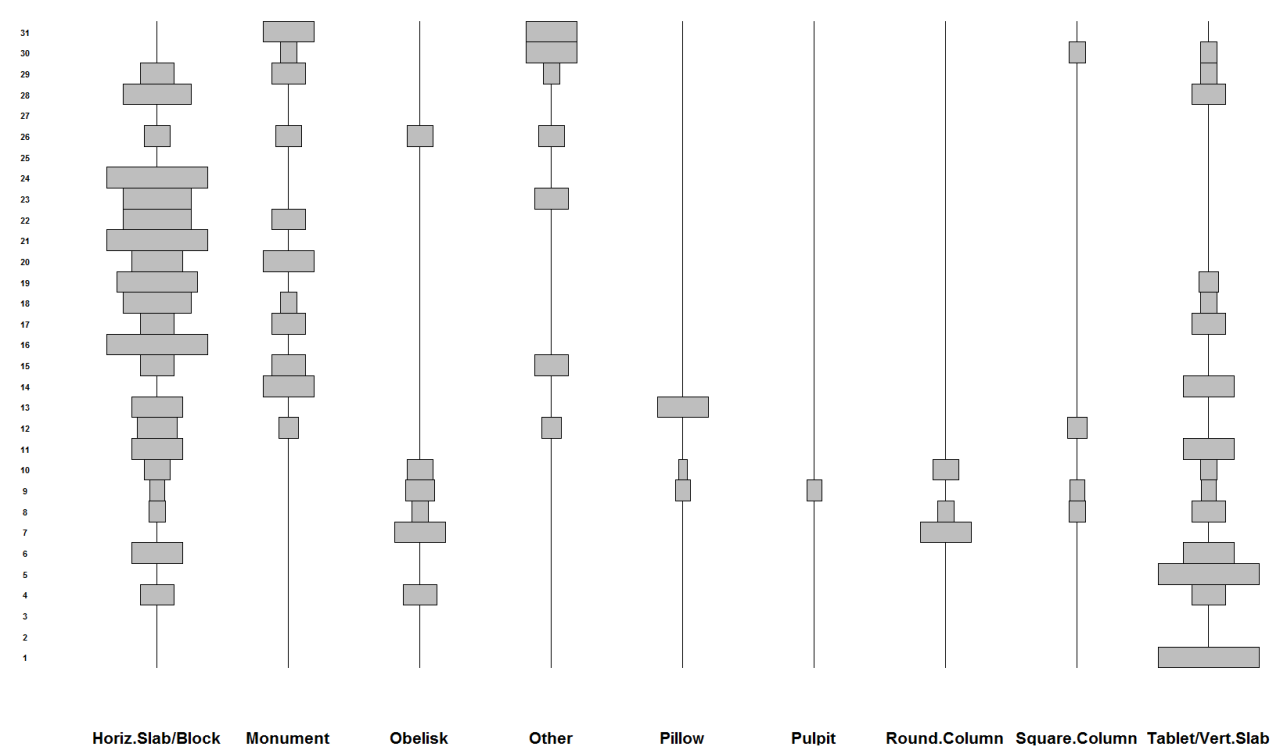During our exploration of the Calvary Cemetery a few weeks ago, we examined whether and how gravestone shape changed through time. But despite each group’s careful recording of shape data from across the cemetery, we quickly found that constructing a meaningful seriation was more or less impossible given the small (n=30) sample of gravestones. By combining class data on gravestone shape, I hoped we could turn individual failure into collective insight. Below I present the ARCHY 469 gravestone shape data in its (near) entirety. With a substantially increased (n=97) sample, distinct “battleship-shaped” curves are evident. (A higher resolution image of the graph can be seen here.)
A few words on methodology. I combined a few gravestone shape categories (e.g. horizontal slab and block) that appeared to be used differently between groups. I also omitted data from family plots. These were not only difficult to log (which gravestone goes with which person?), but also because families, I reasoned, may elect to use a single – and perhaps outmoded – gravestone type in order to preserve plot continuity through time. As such, this seriation presents only single gravemarkers, which should give us an in-depth look at the ways in which Seattleites memorialized deceased individuals over five-year periods between 1861-1865 (phase 1) and 2011-2015 (phase 31).
A number of obvious and interesting trends quickly stand out. The increasing and possibility decreasing popularity of horizontal slabs / blocks, the most frequent gravestone shape, is apparent. In fact, we may be witnessing the emergence of monuments or more unique (“other”) shapes as the preferred grave marker in lieu of relatively unadorned slabs / blocks.
Confirming my and other peoples’ observations, the use of particular gravestone shapes (obelisks, columns, pulpits) is confined to the late nineteenth and early twentieth centuries. Save one late 1980s outlier, the brief rise and fall in obelisk popularity is clearly depicted by this seriation.
I’m interested to hear what patterns others see in this seriation. Why do certain gravestone shapes, such as tablets and monuments, remain consistently popular through time? Would more data would alter this seriation? How so?


Excellent work on collating the data. I agree that family plots differ significantly from individual plots and thus including them in this seriation is both problematic and doesn’t enhance your interpretation of the changing styles of gravestones. Another work around is to perhaps identify family plots as a specific form of memorialization–a shape if you will. Even then you’d want to look at changed between forms of family plots to identify any stylistic differences that change over time.
Ian, I’m stoked that the patrol boats are finally legit battleships! The better data raises more questions for me. For example, I wonder if we had included controls for ethnicity or birth place, that there would be any differences in gravestone shape selection. Were first generation immigrants (if present in the cemetery) more likely to choose a specific shape? Does income level have any effect on the selection of a simpler versus a more elaborate gravestone (historical tax documents/probates might be useful here). Could the slight trend towards monumental gravestones reflect other economic trends (eg increased per capita wealth in Seattle)?
Great questions, Lauryl! It would interesting to see how the price of particular shapes has changed through time and whether the emergence of particular shapes indicates the cemetery became increasingly tailored toward a wealthier clientele.